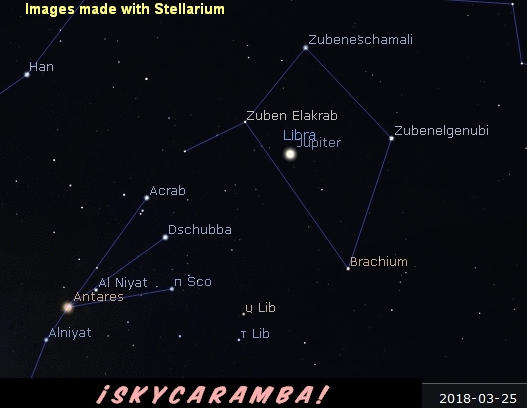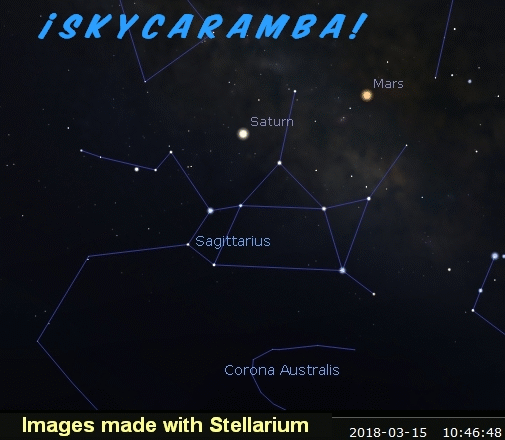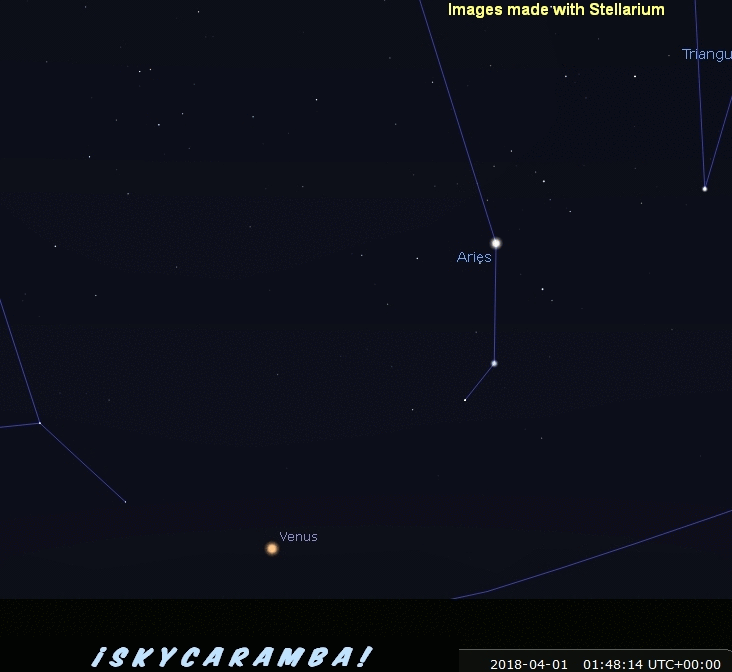
Jupiter late March to mid June 2018
Planet watching is best in the morning this month. Jupiter, actually rising in late evening, remains in the diamond of Libra moving retrograde (westward) toward Zubenelgenubi. If you’ve been watching Mars since the beginning of the year, you’ve seen it pass right on by Jupiter in January and Antares in February. In March, the red planet moved alongside the teapot lid of Sagittarius where much slower Saturn has been since January. Now Saturn and Mars are together at the start of April and easy to see for a few hours before the sun rises. Northern hemisphere viewers should look southeast. Mars doesn’t stay for a long visit, but the moon drops in on them on the 7th. By the end of April, Mars is clearly heading out of Sagittarius on its way to Capricornus.

Saturn and Mars April 2018
Evening stargazing features Venus ever bright but low in the western sky right after sunset. It holds steady night to night as the stars behind it drop into the sun’s glare. A thin crescent moon passes left of the planet on the 18th. Watch the planet pass between the Pleiades and the Hyades on the 27th.

Venus in April 2018
Don’t expect to see much dimmer Mercury this month from the northern hemisphere. It starts April at inferior conjunction. And even though it’s at greatest elongation 27° west of the sun on the 27th, it’s just not well positioned this time for the northern observer at the end of the month. But if you’re seeing it from 25° south, you have the best view with the planet rising about two hours before the sun!
In a sign that northern winter’s over, Orion is setting very early in the evening this month.
Moon phases in April: Last quarter on the 8th, new on the 16th, first quarter on the 22nd, full on the 30th.
The moon’s positions: southern lunistice on the 7th, crossing the equator going north on the 14th, northern lunistice on the 21st, and going south again on the 27th.
The moon is at apogee on the 8th and perigee on the 20th.
Saturn is at aphelion on the 16th at 10.666 astronomical units from the sun. Mercury is at aphelion on the 23rd with a distance of 0.467 a.u. from the sun.
Mercury resumes direct motion on the 14th. Saturn begins retrograde motion on the 17th.
The moon occults Aldebaran on the 19th. The far northern parts of Greenland and Canada’s Northwest Territories are the visibility zone. Regulus is occulted on the 24th. Northern parts of Russia are where to be to see it.
Notable conjunctions this month:
1st Moon 6.9° north of Spica
1st Moon 2.8° north of sun, inferior conjunction
2nd Mars 1.3° south of Saturn
3rd Jupiter 3.8° south of the moon
7th Saturn 1.9° south of the moon
7th Mars 3.1° south of the moon
13th Neptune 1.8° north of the moon
14th Mercury 3.6° north of the moon
16th Uranus 4.4° north of the moon
17th Venus 5.2° north of the moon
18th Uranus 0.5° south of the sun
19th Moon 1.0° north of Aldebaran
24th Moon 1.2° north of Regulus
26th Pluto 1.4° north of Mars
28th Moon 6.9° north of Spica
30th Jupiter 3.7° south of the moon
